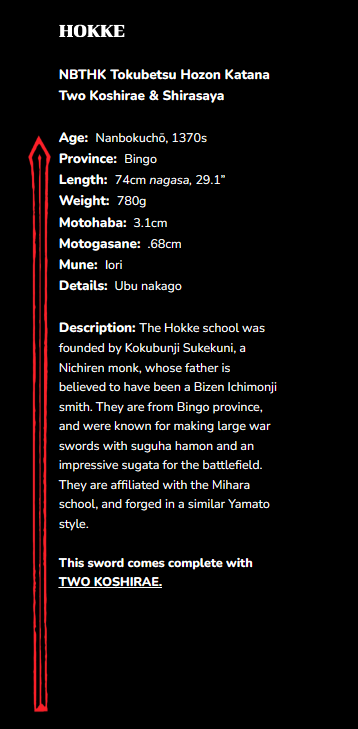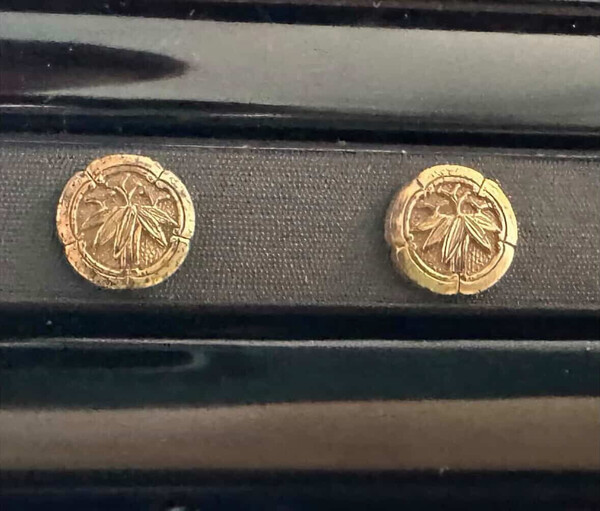-
Posts
288 -
Joined
-
Last visited
-
Days Won
2
Content Type
Profiles
Forums
Events
Store
Downloads
Gallery
Everything posted by JakeNYC
-

NBTHK TOKUBETSU HOZON HOKKE KATANA w. 2 Koshirae
JakeNYC replied to JakeNYC's topic in Swords and Edged Weapons
bump - many people looking and chatting but nobody picking it up just yet. -

NBTHK TOKUBETSU HOZON HOKKE KATANA w. 2 Koshirae
JakeNYC replied to JakeNYC's topic in Swords and Edged Weapons
Bump. 6500 plus shipping. Nanbokucho period with two koshirae and Tokubetsu Hozon. UBU NAKAGO. -

NBTHK TOKUBETSU HOZON HOKKE KATANA w. 2 Koshirae
JakeNYC replied to JakeNYC's topic in Swords and Edged Weapons
6550 - Nanbokucho period, ubu nakago, two koshirae -

NBTHK TOKUBETSU HOZON HOKKE KATANA w. 2 Koshirae
JakeNYC replied to JakeNYC's topic in Swords and Edged Weapons
price reduced -> $6650. Thanks, Jake -

NBTHK TOKUBETSU HOZON HOKKE KATANA w. 2 Koshirae
JakeNYC replied to JakeNYC's topic in Swords and Edged Weapons
This is UBU by the way - I made a typo in the description and called it suriage. -

NBTHK TOKUBETSU HOZON HOKKE KATANA w. 2 Koshirae
JakeNYC replied to JakeNYC's topic in Swords and Edged Weapons
-

NBTHK TOKUBETSU HOZON HOKKE KATANA w. 2 Koshirae
JakeNYC replied to JakeNYC's topic in Swords and Edged Weapons
-

NBTHK TOKUBETSU HOZON HOKKE KATANA w. 2 Koshirae
JakeNYC replied to JakeNYC's topic in Swords and Edged Weapons
-
HOKKE KATANA SURIAGE NBTHK TOKUBETSU HOZON NANBOKUCHO PERIOD (1370s) SHIRASAYA and TWO KOSHIRAE 74CM NAGASA / 29.1" Weight: 780g Motohaba: 3.1cm Motogasane: .68cm Sword Location : NYC Will ship to : ANYWHERE Payment Methods Accepted : zelle, venmo, check, cash Price and Currency : $6750 The Hokke school was founded by Kokubunji Sukekuni, a Nichiren monk, whose father is believed to have been a Bizen Ichimonji smith. They are from Bingo province, and were known for making large war swords with suguha hamon and an impressive sugata for the battlefield. They are affiliated with the Mihara school, and forged in a similar Yamato style. This sword comes with TWO KOSHIRAE. Happy to answer questions if you have any. Please click on photos to see in full resolution. -Jake
-
Thanks Steve! Damn, you're good at that. Will be bringing to the SF show.
-
-
Thanks for the kind words Jussi! Yes that piece sold at the San Francisco sword show. I'm surprised it stayed available for as long as it did. Marcus Sesko examined it at our NYC Token Kai club meeting and believed it was KOTO. At any rate- thanks for the interest and yes it is sold.
-

Kanesaki Omi Yari - NBTHK Hozon for sale
JakeNYC replied to JakeNYC's topic in Swords and Edged Weapons
-

Kanesaki Omi Yari - NBTHK Hozon for sale
JakeNYC replied to JakeNYC's topic in Swords and Edged Weapons
-

Kanesaki Omi Yari - NBTHK Hozon for sale
JakeNYC replied to JakeNYC's topic in Swords and Edged Weapons
-
A large Omi Yari for sale: $1850 USD + Shipping and fees Mumei: Kanesaki NBTHK Hozon Late Muromachi-early Edo Ubu nakago Shirasaya 58CM Nagasa (23") Hamon features repeating togari pattern and is in good polish Located in NYC Can ship anywhere Payment accepted: Check, PayPal, Bank Transfer, Venmo Price: $1850 plus shipping / +PayPal fee if using PayPal Other Info and Full Description : This large Omi Yari was made in Mino province by Kanesaki. It has been awarded a Hozon paper by the NBTHK. Large yari like this were important as functional battlefield weapons and as a way for samurai to display their wealth. The steel has a whitish tint to it, indicative of the steel produced in Mino province in the Muromachi period. The hamon is very healthy and active on all four sides. It features plenty of hataraki to admire and study. There are tobayaki along the spine. There are small signs of prior rusting, but these spots are all inactive and have been polished and removed by an expert in Japan. Let me know if you have any questions. At this price I don't think this will last long. Jake
-
Hi everyone, I'm very pleased to be offering a 14th century Sa school wakizashi. Listing Information: Suriage NBTHK Tokubetsu Hozon Early to Mid Nanbokucho Period (1360s AD) Shirasaya with horn inserts 51CM Nagasa, 20" Very active hamon with togari points, hako, and sunagashi Mokume with "tree rings" as expected Located in NYC Will and have shipped nihonto worldwide Payment Methods Accepted : Check, PayPal, Transfer Price and Currency : 6350 USD + shipping Details: This sword was polished last year by Mr. Akio Muraki. A habaki was made from solid silver in a style often found in Kyushu where the sword was made. Originally a Naginata, this blade has been shortened, but not by much. The polisher believed this to be a late Kamakura blade, and to have only been shortened at the nakago. The NBTHK attributed this blade to a student of Samonji, whose real name was Saemon Saburo Yasuyoshi. Samonji is considered one of the top swordsmiths of all time; he is also known by the name “Ō-Sa”, or “The Great Sa,” since he used the kanji “Sa” (左) to sign his swords. Samonji worked in Chikuzen, in Kyushu, but he differentiated himself from the local tradition around 1340-50 and began to work in the Sōshū style. O-Sa is considered to be one of Masamune’s famous Juttetsu or “Ten Disciples.” O-Sa brought nie-based hataraki, such as kinsuji and sunagashi, to Kyushu. Another characteristic of Sa blades is the irregularity of the yakihaba. According to Kokan Nagayama, the hamon starts with a small pattern called “Samonji Koshiba,” and the width gradually increases toward the top. Kokan Nagayama also indicates that O-Sa’s students’ work features nie zake, and we can see that in this blade. Boshi, referred to as “Sa boshi” have distinguishing midare with saka ashi in the shape of a Jizo. The kaeri are long and the sashikomi polish has highlighted the excellent utsuri. Samonji was also an active teacher, with several students. This Naginata Naoshi was probably made by a direct pupil of Ō-Sa during the early Nanbokucho period. The attribution made by the NBTHK reads “Naginata Naoshi Wakizashi - Sue-Sa; Ō-Sa Ichimon”, meaning “Late-Sa; pupil of Ō-Sa”. “Sa” can mean “different” or “left” and it is a fitting name for someone who dramatically changed nihonto in Kyushu. The sugata is typical of the Mid-Nanbokucho period. -@NYNihonto on IG and Facebook- Please feel free to ask any questions or request more photographs! Will be shipped with a quality oshigata suitable for framing, drawn by myself. Thanks for looking! Jake
- 6 replies
-
- 10
-

-

-

-

Uda Kuninari Katakiriba Katana for sale NBTHK HOZON (KOTO)
JakeNYC replied to JakeNYC's topic in Swords and Edged Weapons
-

Uda Kuninari Katakiriba Katana for sale NBTHK HOZON (KOTO)
JakeNYC replied to JakeNYC's topic in Swords and Edged Weapons








